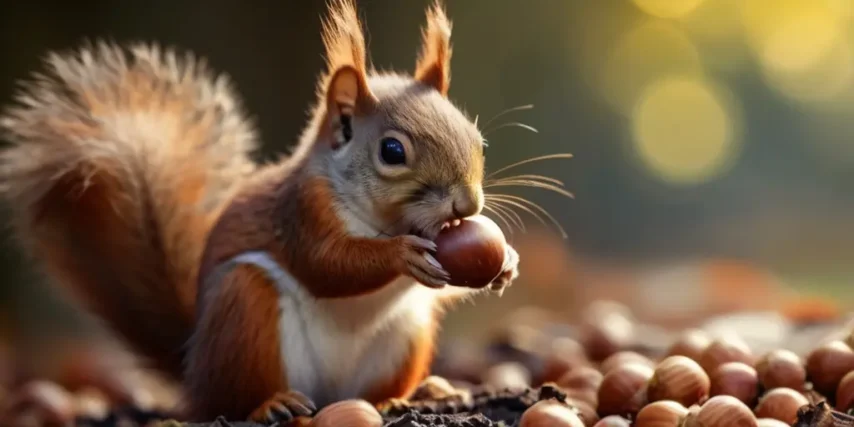The Nutty Tale: Unraveling the Fascination of Squirrels with Hazelnuts
In the intricate tapestry of nature, there exists a charming creature that captures the hearts of many with its acrobatic antics and bushy tail – the squirrel. These small, furry rodents are not only delightful to watch but also intriguing in their behavior, especially when it comes to their affinity for hazelnuts. In this exploration, we delve into the fascinating world of squirrels, unraveling the reasons behind their love for hazelnuts.
A Nutritional Bonanza:
Squirrels are known for their keen instinct when it comes to foraging for food. In the wild, they encounter a variety of nuts, seeds, fruits, and vegetation. Hazelnuts, however, stand out as a nutritional bonanza for these agile creatures. Packed with essential nutrients such as proteins, healthy fats, and a range of vitamins and minerals, hazelnuts provide squirrels with a well-rounded diet that supports their energetic lifestyle.

The high-fat content in hazelnuts is particularly crucial for squirrels, especially during colder seasons. Squirrels are known to hoard food, creating stashes to sustain them through harsh winters. The fats in hazelnuts serve as a valuable energy source, helping these rodents survive when food becomes scarce.
Hazelnuts also contain protein, an essential component for the growth and maintenance of the squirrels’ bodies. Proteins aid in muscle development and repair, crucial for their constant climbing, leaping, and digging activities. Additionally, the diverse nutrient profile of hazelnuts contributes to the overall health and well-being of squirrels.
Natural Instincts and Evolutionary Adaptations:
The love affair between squirrels and hazelnuts is deeply rooted in the evolutionary history of these rodents. Squirrels belong to the family Sciuridae, which includes tree squirrels, ground squirrels, chipmunks, marmots, flying squirrels, and prairie dogs. Within this diverse family, squirrels have developed a specialized set of adaptations that make them highly efficient foragers and nut hoarders.
One notable adaptation is their dental structure. Squirrels possess sharp, chisel-like incisors that are perfect for gnawing through the tough outer shells of nuts, including hazelnuts. These incisors continue to grow throughout their lives, ensuring they can continuously cope with the demands of cracking open nuts to access the nutritious kernels within.
Furthermore, squirrels are highly agile and have an incredible memory. This combination of physical prowess and mental acuity allows them to navigate the complex task of locating and hoarding hazelnuts efficiently. Their excellent spatial memory enables them to remember the locations of numerous nut caches, ensuring a steady supply of food during lean periods.

The Thrill of the Chase:
Beyond the nutritional benefits and evolutionary adaptations, the love squirrels exhibit for hazelnuts also stems from the thrill of the chase. Squirrels are natural foragers, and the process of hunting for hazelnuts becomes a stimulating and engaging activity for them.
In the wild, hazelnuts are often scattered across the forest floor, hidden amongst fallen leaves and debris. Squirrels employ their acute senses, including a keen sense of smell and sharp eyesight, to locate these hidden treasures. The pursuit of hazelnuts mimics a natural hunting instinct, triggering the release of dopamine – a neurotransmitter associated with pleasure – in the squirrels’ brains.
Observing a squirrel in action, deftly maneuvering through branches and leaping from tree to tree in search of hazelnuts, is a spectacle that captivates the observer. This dynamic behavior not only fulfills their dietary needs but also adds an element of excitement to their daily lives.
Human Influence and Squirrel-Human Interactions:
In urban and suburban environments, squirrels often find themselves in close proximity to human habitats. Hazelnuts, being a popular nut among humans, are frequently encountered in parks, gardens, and even backyards. This human-squirrel proximity has led to interesting interactions, further fueling the squirrels’ love for hazelnuts.
Many homeowners and nature enthusiasts take delight in feeding squirrels, often providing them with a stash of hazelnuts. This unintentional provisioning creates a positive association between humans and hazelnuts in the minds of squirrels. As a result, these clever rodents may actively seek out areas where humans are likely to leave food, leading to more frequent encounters with hazelnuts.
The presence of hazelnuts in bird feeders and on outdoor dining tables also contributes to the accessibility of this favored treat for squirrels. The convenience of finding hazelnuts in urban environments further solidifies their preference for this particular nut.
Hazelnuts in Cultural Context:
The love squirrels harbor for hazelnuts is not confined to the realms of nature; it has also permeated cultural narratives and folklore. Hazelnuts have been revered and symbolized differently across various cultures, often associated with wisdom, protection, and even magical properties.
In Celtic mythology, hazelnuts were considered a source of wisdom and poetic inspiration. The hazel tree was believed to be a conduit for divine knowledge, and hazelnuts, with their rich flavor and nutritional value, were seen as a gift from the gods.

In modern times, hazelnuts have become a staple ingredient in culinary delights, particularly in the form of hazelnut spreads, chocolates, and desserts. This culinary connection has elevated the status of hazelnuts, making them a sought-after treat not only for squirrels but also for humans.
The love affair between squirrels and hazelnuts is a multifaceted tale that intertwines biology, evolution, and cultural symbolism. From the nutritional benefits that hazelnuts offer to the intricate adaptations of squirrels, every aspect of this relationship contributes to the charm of these fascinating rodents.
As we observe squirrels darting through treetops and scouring the ground for hazelnuts, it’s evident that this love goes beyond mere sustenance. It encompasses the thrill of the chase, the joy of discovery, and the enduring connection between nature and its inhabitants.
So, the next time you spot a squirrel nibbling on a hazelnut in your backyard or a park, take a moment to appreciate the intricate dance of nature unfolding before your eyes. In the heart of this nutty tale lies a profound connection between a curious rodent and the humble hazelnut – a connection that adds a touch of magic to the ever-evolving narrative of the natural world.







